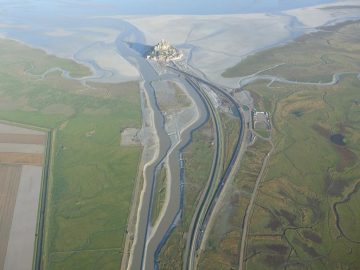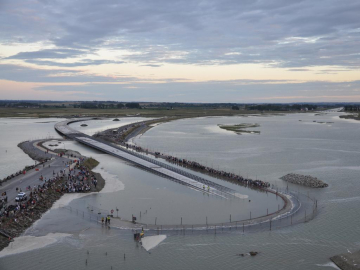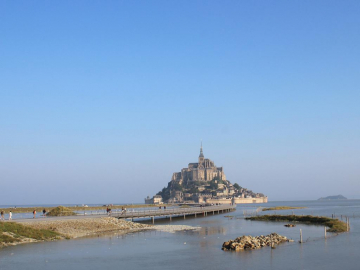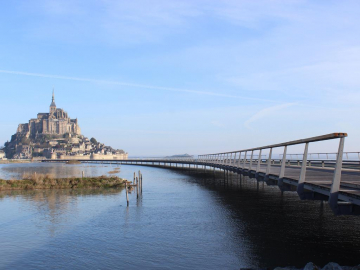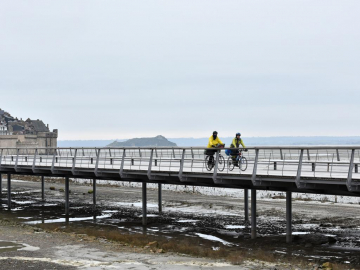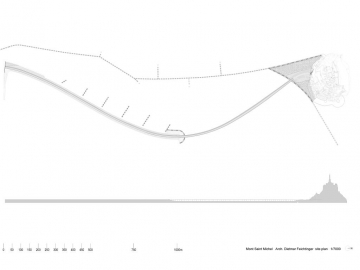The Jetty | Walking on Water
Creating a new access to one of the most remarkable cultural monuments and landscapes in Europe is a rare challenge for the design of a causeway. Human intervention is delicate. The new causeway and jetty with a total length of two kilometres search for continuity and perfect integration into the site. In 1897 a dam exceeding the highest level of high tide was built to connect the land to the Mont Saint Michel Island to assure permanent safe access for visitors. By obstructing the Couesnon River partially sand was accumulating approaching the continent to the island. In order to preserve the island a new causeway and a 756 meters long jetty replace the existing road allowing water to circulate and to restore the insularity of the Mont-Saint-Michel.
The jettys design blends into the landscape by achieving a maximum of transparency. Perfectly horizontal, the deck merges into the horizon contrasting the verticality of the abbey. Its slenderness is achieved by a sequence of 134 pillars with only 24,4 cm of diameter and a distance of 12metres between each pair. Obstruction to water is minimized. The pillars are fixed on the bottom into the foundation concrete pillars with a diameter of 120cm founded on rock about 30 meters under sea level - and on top to the deck avoiding any diagonal structural element to achieve its pure appearance.
From the mainland to the Mont, the general geometry forms a continuous curve. Slightly offset to the East before turning back, it offers a variety of views. The jetty becomes part of the bay following the smooth lines designed by water.
The new causeway and jetty assure a safe walkway for visitors as well as a central roadway for shuttle services.
Bi-directional shuttle busses assure the connection of the new parking on the continent to the Island using the central part with a width of 6m50. It grows constantly up to a width of 8m50 at the terminal which is situated in a distance of 300 meters to the entrance in the defense wall of the Mont. Walkways for pedestrians run along the road on either side with varying widths according to the expected crowd of pedestrians: a main connection 4m50 wide on the west side 5m50 on the terminal, a secondary walkway 1m50 wide on the east 2m50 on the terminal. The central road carries the walkways on cantilevers, large balconies offering fantastic perspectives. The columns are situated under the central part. The shadow of the balcony enforces their discrete appearance.
During high tide sea level is just under the level of the deck giving the impression of walking on water. The last two hundred meters of the jetty are descending by 1% leading to a concrete platform facing the Mont. The platform is submerged several days a year on high tide and provides total insularity of the Mont Saint-Michel.
Few materials are applied harmonizing with the colours of the bay. Whenever possible they are applied untreated. The modification of the aspect with time and weather conditions corresponds to the roughness of the medieval constructions. The main structure in steel is coated with a metallic light grey finishing on the anti-
corrosion complex. The deck of the walkways on the sides is in oak wood without treatment. The wood cladding is factory pre mounted forming panels with stainless steel fixation underneath. The formal simplicity allows perfect integration. It hides the complexity of a sophisticated technical approach.
The coherence of the architectural and technical approach reflects the ambition to magnify this beautiful site.

